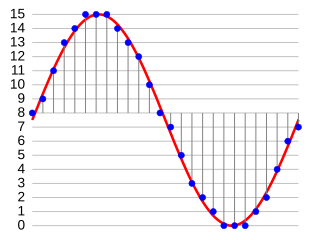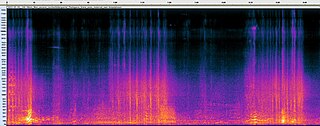This article needs additional citations for verification .(April 2024) |
Discontinuous transmission (DTX) is a means by which a mobile telephone is temporarily shut off or muted while the phone lacks a voice input. [1] [2]
This article needs additional citations for verification .(April 2024) |
Discontinuous transmission (DTX) is a means by which a mobile telephone is temporarily shut off or muted while the phone lacks a voice input. [1] [2]
A common misconception is that DTX improves capacity by freeing up TDMA time slots for use by other conversations. In practice, the unpredictable availability of time slots makes this difficult to implement. However, reducing interference is a significant component in how GSM and other TDMA based mobile phone systems make better use of the available spectrum compared to older analog systems such as Advanced Mobile Phone System (AMPS) and Nordic Mobile Telephone (NMT). While older network types theoretically allocated two 25–30 kHz channels per conversation, in practice some radios would cause interference on neighbouring channels making them unusable, and a single radio may broadcast too strong an oval signal pattern to let nearby cells reuse the same channel.
GSM combines short packet sizes, frequency hopping, redundancy, power control, digital encoding, and DTX to minimize interference and the effects of interference on a conversation. In this respect, DTX indirectly improves the over-all capacity of a network.
In packet radio systems such as GPRS/EDGE, it is possible to combine DTX with capacity increase when VoIP is used for telephony. In such cases, resources freed up when one user is in silence can be used to serve another user. The increase of the number of users will contribute to the interference level. Systems that use voice codecs such as AMR can reduce vocoder rate adaptively to better combat interference.
Systems based upon CDMA air interfaces such as IS-95/CDMA2000, and most forms of UMTS, can use a form of implied DTX by usage of a variable rate codec such as AMR. As with the packet radio systems above, when one side of the conversion is silent, the amount of transmitted data is minimized. Again, the effect is reduced interference. [3]
In wireless transmitters, VAD is sometimes called voice-operated transmission (VOX).
Speech frame = 260 samples
Performs SP flag monitoring and Channel coding
After the transition from VAD=1 to VAD=0, a "hangover period" of N+1 consecutive frames is required to make a new updated SID frame available. The bursts are directly passed to RSS with SP=1.
Background noise spikes can often be confused with the speech frame and hence, in order to nullify this issue, a check list for SID computation is Nelapsed >23, old SID is utilized with VAD=0.
Once after the end of speech SID is computed it is continuously passed to the RSS marked with SP=0 as long as VAD=0.
If a SID (SP=0) is chosen for transmission is stolen for FACCH signaling than the subsequent frame is scheduled for transmission.
A FACCH frame in not considered as a meaningful information and should be transmitted with BFI=1
Traffic frames aligned with SACCH multi frame have TAF (time alignment flag)=1
RX DTX handler performs speech decoding and comfort noise computation.
Performs Error Correction and Detection and SID frame detection
Whenever a good speech frame is detected the RX DTX handler shall pass directly to speech decoder. Whenever a lost speech or lost SID frames are detected the substitution or mutation shall be applied. Whenever a valid SID frame result in comfort noise generation. In case of invalid SID frame after consecutive Speech frames the last valid SID frame will be applicable.

Code-division multiple access (CDMA) is a channel access method used by various radio communication technologies. CDMA is an example of multiple access, where several transmitters can send information simultaneously over a single communication channel. This allows several users to share a band of frequencies. To permit this without undue interference between the users, CDMA employs spread spectrum technology and a special coding scheme.

Time-division multiple access (TDMA) is a channel access method for shared-medium networks. It allows several users to share the same frequency channel by dividing the signal into different time slots. The users transmit in rapid succession, one after the other, each using its own time slot. This allows multiple stations to share the same transmission medium while using only a part of its channel capacity. Dynamic TDMA is a TDMA variant that dynamically reserves a variable number of time slots in each frame to variable bit-rate data streams, based on the traffic demand of each data stream.
A frame is a digital data transmission unit in computer networking and telecommunications. In packet switched systems, a frame is a simple container for a single network packet. In other telecommunications systems, a frame is a repeating structure supporting time-division multiplexing.

Time-division multiplexing (TDM) is a method of transmitting and receiving independent signals over a common signal path by means of synchronized switches at each end of the transmission line so that each signal appears on the line only a fraction of time according to agreed rules, e.g. with each transmitter working in turn. It can be used when the bit rate of the transmission medium exceeds that of the signal to be transmitted. This form of signal multiplexing was developed in telecommunications for telegraphy systems in the late 19th century but found its most common application in digital telephony in the second half of the 20th century.
Speex is an audio compression codec specifically tuned for the reproduction of human speech and also a free software speech codec that may be used on voice over IP applications and podcasts. It is based on the code excited linear prediction speech coding algorithm. Its creators claim Speex to be free of any patent restrictions and it is licensed under the revised (3-clause) BSD license. It may be used with the Ogg container format or directly transmitted over UDP/RTP. It may also be used with the FLV container format.
In telecommunications and computer networks, a channel access method or multiple access method allows more than two terminals connected to the same transmission medium to transmit over it and to share its capacity. Examples of shared physical media are wireless networks, bus networks, ring networks and point-to-point links operating in half-duplex mode.

Interim Standard 95 (IS-95) was the first digital cellular technology that used code-division multiple access (CDMA). It was developed by Qualcomm and later adopted as a standard by the Telecommunications Industry Association in TIA/EIA/IS-95 release published in 1995. The proprietary name for IS-95 is cdmaOne.

A cellular network or mobile network is a telecommunications network where the link to and from end nodes is wireless and the network is distributed over land areas called cells, each served by at least one fixed-location transceiver. These base stations provide the cell with the network coverage which can be used for transmission of voice, data, and other types of content via radio waves. Each cell's coverage area is determined by factors such as the power of the transceiver, the terrain, and the frequency band being used. A cell typically uses a different set of frequencies from neighboring cells, to avoid interference and provide guaranteed service quality within each cell.
The Adaptive Multi-Rateaudio codec is an audio compression format optimized for speech coding. AMR is a multi-rate narrowband speech codec that encodes narrowband (200–3400 Hz) signals at variable bit rates ranging from 4.75 to 12.2 kbit/s with toll quality speech starting at 7.4 kbit/s.
In communications, Circuit Switched Data (CSD) is the original form of data transmission developed for the time-division multiple access (TDMA)-based mobile phone systems like Global System for Mobile Communications (GSM). After 2010 many telecommunication carriers dropped support for CSD, and CSD has been superseded by GPRS and EDGE (E-GPRS).
Adaptive Multi-Rate Wideband (AMR-WB) is a patented wideband speech audio coding standard developed based on Adaptive Multi-Rate encoding, using a similar methodology to algebraic code-excited linear prediction (ACELP). AMR-WB provides improved speech quality due to a wider speech bandwidth of 50–7000 Hz compared to narrowband speech coders which in general are optimized for POTS wireline quality of 300–3400 Hz. AMR-WB was developed by Nokia and VoiceAge and it was first specified by 3GPP.

G.729 is a royalty-free narrow-band vocoder-based audio data compression algorithm using a frame length of 10 milliseconds. It is officially described as Coding of speech at 8 kbit/s using code-excited linear prediction speech coding (CS-ACELP), and was introduced in 1996. The wide-band extension of G.729 is called G.729.1, which equals G.729 Annex J.
Voice activity detection (VAD), also known as speech activity detection or speech detection, is the detection of the presence or absence of human speech, used in speech processing. The main uses of VAD are in speaker diarization, speech coding and speech recognition. It can facilitate speech processing, and can also be used to deactivate some processes during non-speech section of an audio session: it can avoid unnecessary coding/transmission of silence packets in Voice over Internet Protocol (VoIP) applications, saving on computation and on network bandwidth.
Comfort noise is synthetic background noise used in radio and wireless communications to fill the artificial silence in a transmission resulting from voice activity detection or from the audio clarity of modern digital lines.

Background noise or ambient noise is any sound other than the sound being monitored. Background noise is a form of noise pollution or interference. Background noise is an important concept in setting noise levels.
The term silence suppression is used in telephony to describe the process of not transmitting information over the network when one of the parties involved in a telephone call is not speaking, thereby reducing bandwidth usage.

G.718 is an ITU-T Recommendation embedded scalable speech and audio codec providing high quality narrowband speech over the lower bit rates and high quality wideband speech over the complete range of bit rates. In addition, G.718 is designed to be highly robust to frame erasures, thereby enhancing the speech quality when used in Internet Protocol (IP) transport applications on fixed, wireless and mobile networks. Despite its embedded nature, the codec also performs well with both narrowband and wideband generic audio signals. The codec has an embedded scalable structure, enabling maximum flexibility in the transport of voice packets through IP networks of today and in future media-aware networks. In addition, the embedded structure of G.718 will easily allow the codec to be extended to provide a superwideband and stereo capability through additional layers which are currently under development in ITU-T Study Group 16. The bitstream may be truncated at the decoder side or by any component of the communication system to instantaneously adjust the bit rate to the desired value without the need for out-of-band signalling. The encoder produces an embedded bitstream structured in five layers corresponding to the five available bit rates: 8, 12, 16, 24 & 32 kbit/s.
In digital telephony, a talkspurt is a continuous segment of speech between silent intervals where only background noise can be heard. Segmenting speech streams into talkspurts allows bandwidth to be conserved by not sending excess data in silent intervals, and also allows synchronization, buffering and other parameters of the communications system to be readjusted in the intervals between talkspurts.
GSM radio frequency optimization is the optimization of GSM radio frequencies. GSM networks consist of different cells and each cell transmit signals to and receive signals from the mobile station, for proper working of base station many parameters are defined before functioning the base station such as the coverage area of a cell depends on different factors including the transmitting power of the base station, obstructing buildings in cells, height of the base station and location of base station. Radio Frequency Optimization is a process through which different soft and hard parameters of the Base transceiver stations are changed in order to improve the coverage area and improve quality of signal. Besides that there are various key performance indicators which have to be constantly monitored and necessary changes proposed in order to keep KPIs in agreed limits with the mobile operator.

Opus is a lossy audio coding format developed by the Xiph.Org Foundation and standardized by the Internet Engineering Task Force, designed to efficiently code speech and general audio in a single format, while remaining low-latency enough for real-time interactive communication and low-complexity enough for low-end embedded processors. Opus replaces both Vorbis and Speex for new applications, and several blind listening tests have ranked it higher-quality than any other standard audio format at any given bitrate until transparency is reached, including MP3, AAC, and HE-AAC.